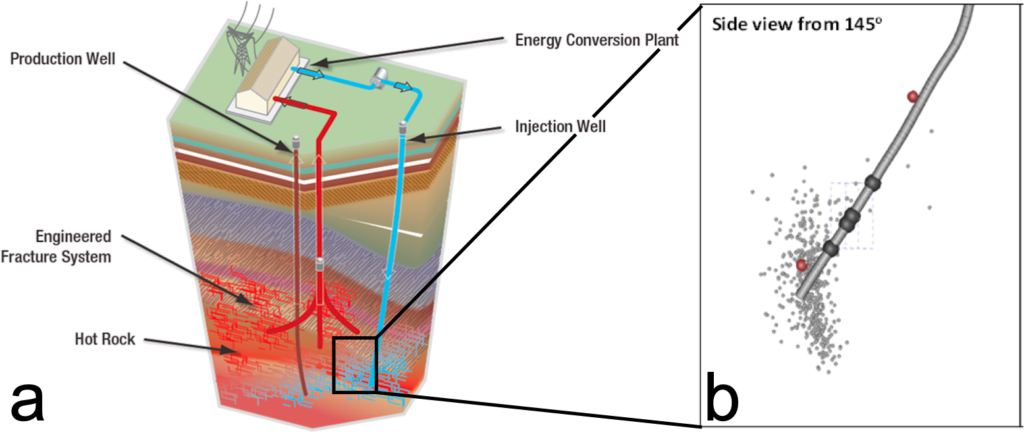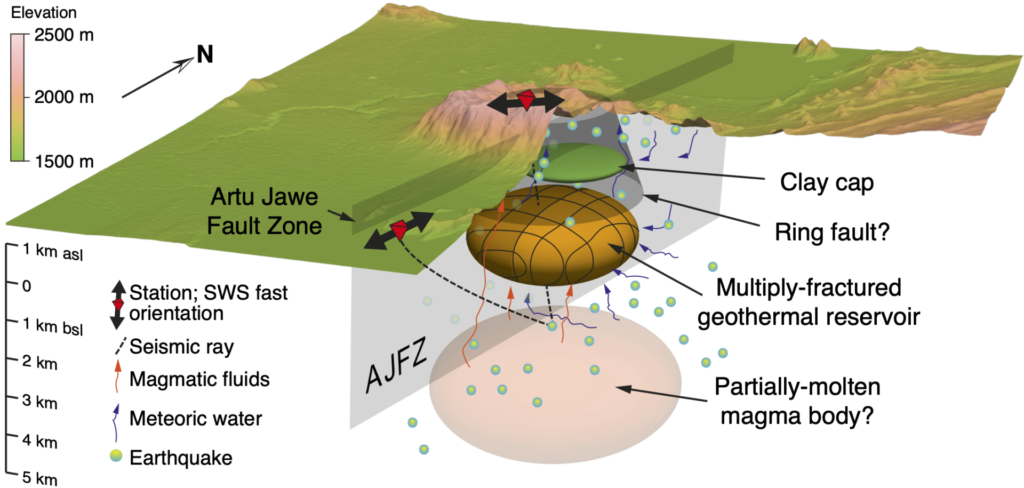Understanding geothermal and volcanic systems using seismic recordings

Introduction
To meet global and UK targets for the reduction of carbon emissions, and thus limit future climate change, more renewable power sources are needed to replace those which emit greenhouse gases. Alongside wind and solar, which are subject to changes in the weather, geothermal systems are one type of resource which can produce reliable ‘base load’ power at all times. However, geothermal power is still relatively under-developed in many countries, including the UK, despite large potential for its exploitation. In this geothermal PhD, you will help us better understand how geothermal systems work using seismic data.
In many places such as Iceland, the East African Rift and the Geysers in California, geothermal power production can take advantage of ‘high enthalpy’ systems, containing high-temperature fluids where steam can be produced just by drilling. This is not the case in many other places such as the UK, Switzerland and Utah—however frequently so called ‘hot dry rock’ systems are available. Here, usually igneous rocks produce heat, but water does not percolate through. This then requires water to be introduced to the system under pressure, and new permeability to be created, in order for the fluids to pass through and ultimately be extracted again at the surface to produce electrical power. This is called an ‘enhanced geothermal system’ (EGS), and the process is similar to hydraulic fracturing in shale gas reservoirs. Just as in gas production, it often causes microearthquakes, and has the potential to trigger larger felt earthquakes.

One of the key limiting factors therefore in taking advantage of geothermal power—especially in densely-populated places such as the UK—is avoiding the triggering of large earthquakes, which in recent years has notably occurred in Pohang, Korea and Basel, Switzerland. Existing protocols to control the production process and avoid damaging seismicity take advantage of the latest geomechanical, petrophysical, geochemical and seismic understanding of EGSs. However, the protocols are often based on observed earthquake magnitudes, despite the fact that this depends on the location of the earthquake which cannot be known with perfect accuracy (Roy et al., 2021), and there remains much uncertainty on why any given felt earthquake was triggered at a particular time, or what upper limit if any there is on the magnitude of induced earthquakes. In other cases, it is unclear where injected fluids go or how large a volume has been fractured. Therefore there is a great need for further study of how EGSs react when fractured, and how geothermal systems behave in general.
In this project, you will use seismic data recorded at various geothermal systems throughout the world to study the triggering of (micro)earthquakes, and use the signal from these to better understand the conditions present in and around the geothermal reservoir. You will also take advantage of the noise travelling across the seismic system to obtain further information about the changes in seismic velocities through time and improve understanding of the velocity structure, which is needed for subsequent seismic analysis and monitoring. In both cases, machine learning (ML) techniques may be important (Holtzman et al., 2018)—and if you are interested in this, then time is available to use and develop ML methods in this project.
Objectives
In this PhD project, you will work with leading researchers at Leeds with backgrounds in seismology and geothermal power. Initially, work will focus on measuring seismicity and seismic anisotropy and objectives include:
- Examine the relationship between fluid injection and seismicity by searching for seismicity using new low-signal-to-noise methods for automatically detecting earthquakes (Shi et al., 2018).
- Measure shear-wave splitting in waves released by microearthquakes during production, and examine how anisotropy changes with time and as the rock mass is affected (e.g., Nowacki et al., 2018). Use these results to infer how fractures develop throughout the stimulation process.
- Compare the induced seismicity at EGS sites to natural seismicity at high-enthalpy sites.
- Combine your seismic observations with available electrical, magnetic, petrological, geochemical and other data to better characterise the geothermal reservoir.
The initial targets for this work will be the Utah FORGE EGS site, and the natural seismicity at Aluto in Ethiopia (Nowacki et al., 2018), however flexibility in the project means alternative sites and research questions can be explored. The exact work plan and research area can be tailored to your experience and interests.

Impact of this work
There is a pressing global need to pursue carbon-free energy sources, so the work in this project will be immediately useful in geothermal power production worldwide. Alongside this, the work will help with the fundamental understanding of geothermal systems. Hence it is expected that successful candidates will be in a strong position to publish their work in high-impact journals in a number of articles. Global interest in the work will also allow for travel to international conferences to present your findings.
Applicant suitability
This project would suit candidates with an interest in the fundamental way in which the Earth behaves, a desire to apply this to a physical system which matters to society, and a passion for interrogating datasets by both using existing computational seismic techniques and possibly developing new ones. You will need to be able to collate seismic data, process it using available tools, develop new tools where appropriate, and model your data using existing modelling workflows. Candidates will usually be armed with undergraduate training in areas such as geophysics, physics, geology, applied mathematics and similar branches of quantitative science. Programming experience is advantageous but not essential.
Training environment
You will be a key member of a team of researchers across the School of Earth and Environment tackling fundamental problems in the study of the solid Earth. You will be part of the Seismology, Geothermal and Applied Geophysics research groups in the Institutes of Geophysics and Tectonics, and Applied Geoscience, interacting daily with not only your supervisors, but other senior colleagues, postdoctoral researchers and fellow PhD students. You will also have the opportunity to devise and co-supervise research projects for undergraduate and masters students. In this project, you will be trained in many transferrable scientific skills, including analysis of large datasets, high-performance computer modelling, probabilistic inversion of geophysical data, and the dynamic communication of your ideas. Study for a PhD in the Seismic and Applied Geophysics groups involves international travel to conferences and the possibility of seismic fieldwork. You will be supported in identifying a field site and obtaining the resources to deploy the group’s fleet of seismic nodes to study geothermal-related phenomena, if appropriate. As a member of the Panorama Doctoral Training Programme, you will received tailored training alongside a cohort of other postgraduate researchers.
References and further reading
- Farndale, H., Law, R., 2022. An update on the United Downs Geothermal Power Project, Cornwall, UK, in: Proceedings of the 47th Workshop on Geothermal Engineering. Stanford University, Stanford, USA, pp. 1–13.
- Holtzman, B.K., Paté, A., Paisley, J., Waldhauser, F., Repetto, D., 2018. Machine learning reveals cyclic changes in seismic source spectra in Geysers geothermal field. Science Advances, 4, eaao2929. https://doi.org/10.1126/sciadv.aao2929
- Nowacki, A., Wilks, M., Kendall, J.-M., Biggs, J., Ayele, A., 2018. Characterising hydrothermal fluid pathways beneath Aluto volcano, Main Ethiopian Rift, using shear wave splitting. Journal of Volcanology and Geothermal Research, 356, pp. 331–341. https://doi.org/10.1016/j.jvolgeores.2018.03.023
- Olasolo, P., Juárez, M.C., Morales, M.P., D´Amico, S., Liarte, I.A., 2016. Enhanced geothermal systems (EGS): A review. Renewable and Sustainable Energy Reviews, 56, 133–144. https://doi.org/10.1016/j.rser.2015.11.031
- Roy, C., Nowacki, A., Zhang, X., Curtis, A., Baptie, B., 2021. Accounting for natural uncertainty within monitoring systems for induced seismicity based on earthquake magnitudes. Earth Sci., 9, 634688. https://doi.org/10.3389/feart.2021.634688
- Shi, P., Nowacki, A., Rost, S., Angus, D.A., 2018. Automated seismic waveform location using Multichannel Coherency Migration (MCM)–II. Application to induced and volcano-tectonic seismicity. Geophysical Journal International, 216, pp. 1608–1632. https://doi.org/10.1093/gji/ggy507
